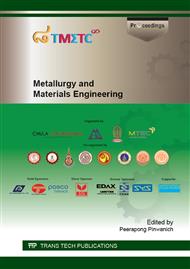p.3
p.8
p.14
p.19
p.25
p.31
p.36
p.42
Effect of Thermal Exposure on Long-Term Heated Microstructures at 900°C of Nickel Base Superalloy Turbine Blade, Grade Inconel 738
Abstract:
The objectives of this research are to search for the most appropriate heat treatment condition for rejuvenating microstructure of cast nickel base superalloy, grade IN-738, turbine blades after using to prolong its life time service again. The turbine blades that had been used for long term service under load and high temperatures resulted in small gamma prime particles connecting to each other and thus forming into larger particles. This effect generally reduces creep resistance and increases the failure. In this research, 5 IN-738 superalloy samples were reheat-treated under simulation of 2 working conditions. First, they were heated at 900oC. At every 400 hours from the beginning of heat treatment until time reaching 1600 hours, these samples were collected and examined the microstructures, size and area fraction of gamma prime particles. Another heating program, they received an over thermal exposure heating at 1125oC for 1 hour after long-term heated at 900oC after every 400 hours-heating. Then the results were analyzed from working conditions. It was found that the sample passed solutioning at 1125oC for 4 hours and aging at 845oC for 24 hours with the over thermal exposure showed the most stable phase stability with γ’ phase increasing after long-term simulated working conditions .
Info:
Periodical:
Pages:
19-24
Citation:
Online since:
July 2015
Price:
Сopyright:
© 2015 Trans Tech Publications Ltd. All Rights Reserved
Share:
Citation:


